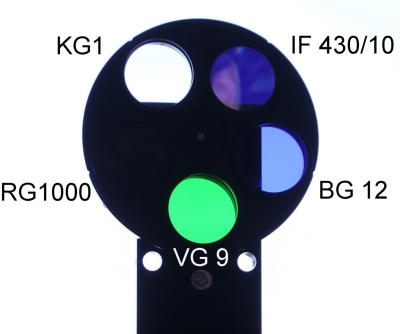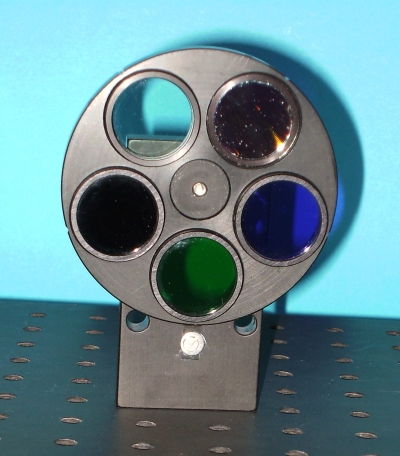1. Light and Radiation
Spectral analysis: Colour glass filters (1/4)
Photographers use colour glass filters for producing colour effects, or to avoid unwanted components of daylight such as ultraviolet which can cause excessive bluish cast in outdoor photography.
Spectral measurements with colour glass filters are also commonly done in the laboratory. The image below shows a filter wheel equipped with several filters. By rotating the wheel, each filter can be positioned to the path of rays which is at the bottom of the wheel. The image on the right shows the same filter wheel in a backlight photo.
Colour glass filters allow for an easy selection of the desired spectral ranges in radiation measurements.
However, each measured wavelength requires a suitable filter, so this method is only practical for analysing not more than 10 spectral bands. Such instruments with more or less this number of spectral bands are said to be multispectral, while hyperspectral sensors measure data at 64, 128 or 256 different wavelengths. Instruments which measure luminosity in a broader spectral range and display their data as grey levels, e.g., in black-and-white images, are said to be panchromatic.
One disadvantage of using colour glass filters is that selected spectral bands can only be modified by changing the filters. Instruments used in satellites do not allow such a filter change. Much care is therefore taken during the planning phase of a satellite instrument in order to define the best suitable wavelengths for each particular mission.

The table below indicates the spectral bands of the Thematic Mapper (TM) abord NASA's satellite Landsat 7 and of the SPOT 5 multispectral instrument of SPOT IMAGE. You may notice that the spectral bands of the two satellites which were both conceptualised for the remote sensing of land surfaces are very much alike.
| TM | SPOT 5 | Spectral range | Signal type |
|---|---|---|---|
| 0.45-0.52 μm | blue-green | reflective | |
| 0.52-0.60 μm | 0.50-0.59 μm | green-yellow | reflective |
| 0.63-0.69 μm | 0.61-0.68 μm | red | reflective |
| 0.76-0.90 μm | 0.78-0.89 μm | near IR | reflective |
| 1.55-1.75 μm | 1.58-1.75 μm | mid IR | reflective |
| 10.40-12.50 μm | thermal IR | emissive | |
| 2.08-2.35 μm | mid IR | reflective | |
| 0,59-0,90 μm | 0,48-0,71 μm | panchromatic | reflective |
Under signal type, reflective refers to reflected sun radiation and emissive refers to thermal emission of the Earth.


